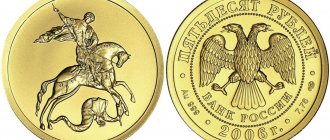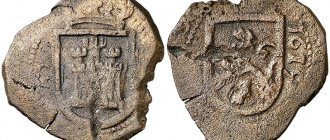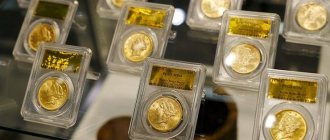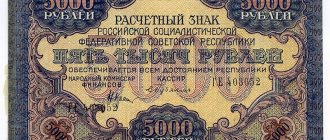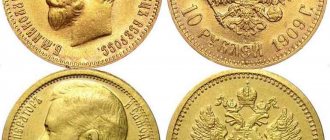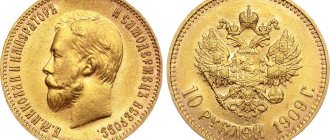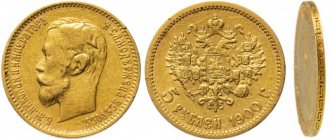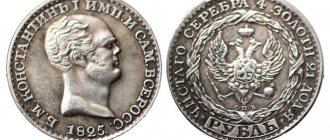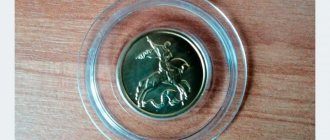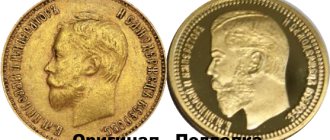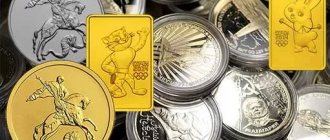First, let’s understand how investment coins differ from collectible coins. Investment pieces are usually produced in large quantities and in quality no higher than uncirculated diamond.
Collector's issues are produced in limited quantities and are minted using the proof technology. When purchasing the Victorious investment coin, there is no need to pay VAT.
Investment coins of St. George the Victorious may be of interest to both investors and hoarders. If the latter only protect their savings from inflation by purchasing precious metals, then investors want to provide themselves with additional income due to price changes.
“Victorious” coins in denominations of 50 rubles
According to representatives of the Bank of Russia, the 2006 “Victorious” coins were the result of an entire era of minting gold chervonets, starting in 1975 and ending in 1982.
When the “Sower” became an investment coin, its reserves collected during the Soviet Union in the bins of the Central Bank were quickly sold out. The banks were worried. After all, no one was in a hurry to hand over the gold money back. There was a void that needed to be filled. At that time, investment coins were minted abroad from gold with a purity of “three nines” and higher. Experience of such work was available at the then Leningrad Mint, which since 1991 has been producing the “Russian Ballet” cycle in plain quality with a purity of 585, as well as in “proof” quality with a purity of 999.
The design of the “Victorious” was tested in the golden cycle, dedicated to the zodiac symbols and produced from 2003 to 2005. The main similarity with the future investment “St. George the Victorious” is its simple quality, the “three nines” hallmark and the unpretentious design of the reverse side. The author of the design was the national Russian artist A.V. Baklanov.
The choice of the nominal denomination of 50 rubles is explained by the fact that the Bank of Russia specially allocated it for gold coins weighing 7.78 grams or ¼ troy ounce. Due to the presence of some impurities in the alloy, the total mass of each specimen is 7.89 grams, thickness 1.6 and diameter 22.6 millimeters. There are 134 teeth on the lateral surface.
The circulation of 150,000 was not enough to satisfy existing demand. Therefore, a year after the start of production, an acute shortage of “Victorious” coins arose in banks.
The issuer met the buyers halfway, and over the next few years the issue was greatly increased. The maximum number of copies was produced in 2009.
In the same year, two versions of the obverse appeared - with a small and large mark of the Moscow Mint. If we consider that the small mark was used from 2006 to 2007, and the large one appeared in 2008, then we can assume the presence of a 2008 “St. George the Victorious” with a small manufacturer’s mark. But so far no one has come across such specimens.
Investment coins “St. George the Victorious”, produced at the St. Petersburg and Moscow mints, have a single numbering according to the catalog of the Bank of Russia. The issuer does not separate them. Does not affect the catalog number and year of minting. You can visually distinguish the Moscow version from the St. Petersburg version by the presence of a completely matte field and pattern in the first one. In specimens made on SPMD, only the field is matte, and the relief looks mirror-glossy.
Instead of a bank logo, every Russian coin from 2021 bears the state emblem.
The production of “George the Victorious” from gold is suspended at this moment. For this reason, the updated design of the front side, created by the sculptor Dolgopolova and the artist Kramskoy, was only seen by everyone in 2021.
Silver Victorious
The Bank of Russia began issuing silver coins in 2009; their design is completely identical to gold ones. Coin characteristics:
- denomination - 3 rubles,
- sample - 999,
- pure metal content - 31.10 g (1 troy ounce),
- diameter - 39 mm.
The circulation of the coin was as follows:
- 01/11/2009 circulation - 280 thousand pieces,
- 01/11/2010 circulation - 500 thousand pieces,
- 07/24/2015 circulation - 100 thousand pieces,
- 12/26/2016 circulation - 18,205 pieces,
- 08/07/2017 circulation - 20 thousand pieces,
- 08/30/2018 circulation - 150 thousand pieces,
- 01/09/2019 circulation - 100 thousand pieces,
- 01/14/2020 circulation - up to 500 thousand pieces.
How has Pobedonosets changed since 2012?
The 2012 mintage, produced in collector's quality, is very different from other coin lots. With similar characteristics, not only ordinary “Victory Bearers” were made, but also double coins with a nominal value of 50 and 100 rubles. Despite the similar themes, they had a different numbering according to the catalog 5216-0086 and 5217-0039, and were also not investment ones. Each denomination was minted in quantities of 10,000 pieces.
But there are also investment “Victory Bearers” of 2012 that are not included in the catalogue. For some reason, the Bank of Russia, contrary to the minted date, lists them as 2013.
Of even greater interest is the 2012 batch, released in a different metal. These coins came in slabs and had a silvery tint. The material used was a copper-nickel alloy. Expert opinion on these specimens is divided. Some consider them trial, others believe that it was a simple custom release.
Where can you buy or sell
If the purpose of the purchase is to invest money and there is no difference when 50 rubles with St. George the Victorious are minted from precious metal, then you can purchase them at any bank branch where such a service is available. I recommend that you first familiarize yourself with the bank’s price list, since each organization has its own price for intermediation.
Banks also buy back 50 rubles “St. George the Victorious” from the population at a lower cost. But if gold prices have increased significantly during ownership, then the selling price may be higher than the costs incurred during the purchase.
If you want to purchase a specific example of “St. George the Victorious” as a collector’s item, and the banks have already sold it out, then the auction remains. There you can find even the rarest copies of 50 rubles of almost any year of manufacture and varying degrees of preservation. However, bullion coins are not a very popular and common item at auctions.
Price table depending on condition
The table was compiled based on the results of completed transactions for the purchase and sale of 50 rubles with St. George the Victorious. Prices marked with a footnote are no longer relevant due to the age of the last transaction and changes in gold prices. Since these are the last recorded passages, there is no data on how much 50 rubles “St. George the Victorious” from these years of production might cost at auction.
| Condition/ 50 rubles “St. George the Victorious”, gold, year of issue | UNC price | Proof price | *Notes, last access date |
| 2006 | 24 500 | — | |
| 2007 | 20 982* | — | 10.04.18 |
| 2008 | 22 954 | — | |
| 2009 | 22 885 | — | |
| 2010 | 26 650 | — | |
| 2012 | 19 431* | 24 044 | 03.08.17 |
| 2014 | 20 582* | — | 30.11.17 |
| 2015 | 21 389* | — | 23.11.17 |
| 2018 | — | — | No data |
List of gold editions of “Victorious”
Since “St. George the Victorious” coins are of not only investment, but also collection interest, it will be useful to know about the mintages of different years. This will help to understand the rarity and value of a particular specimen. The data below duplicates information from the catalogs of the Bank of Russia, but may not coincide with the plans of the Central Bank once published. Thus, the 2015 release from the planned hundreds of thousands of units eventually decreased to 30,000. And the 500,000 copies planned for 2016 were not minted at all. Circulations are not included as “proof” in the list.
For 2021, the Central Bank planned to issue up to 500,000 copies. However, this information will be clarified only in the catalog published in 2021. Planned circulations for 2021 and 2022 are not yet known.
History of appearance
The prototype of St. George the Victorious - an armed horseman in various design options - has been used as a heraldic symbol since the 13th century. At the end of the 15th century, the image of a rider piercing a dragon under the hooves of his horse predominated.
In the 30-40s of the 16th century, the image was transferred to money, and already in 1562 the image was placed on the chest of a double-headed eagle. The horseman personified the sovereign defeating his enemies. For the first time it was named George the Victorious by Peter I in 1710, and at the same time it was officially approved as a symbol of Moscow.
When the need arose to create an investment coin, the choice fell on the image of St. George the Victorious, and in 2006 the Bank of Russia issued the first 150 thousand fifty-ruble coins of the same name.
It's interesting to know
The high standard of the precious metal in the first issues of “Victorious” pleased not only investors. It is said that many of these coins were purchased for the needs of dentistry and jewelry workshops. Although, this may only be a reason to increase the cost of 2006 copies.
The design of these coins combines St. George the Victorious from penny denominations and the double-headed coat of arms from more expensive metal money.
According to information for 2015, 27 tons of pure gold were used for production.
If we do not count circulations with the collector’s proof quality, then in the period 2006-2019, 4,710,000 copies of “Victorious” were minted. If the 2021 plan is completed, the total number of coins will become more than 5 million.
St. George is minted on money not only in Russia, but also in Britain, where he is present on sovereigns. However, there he has a sword in his hands, not a spear.
Mints
Coin with the image of St. George the Victorious. Mint Yekaterinburg
The Red Mint, as the mint in Moscow was called, minted coins distinguished by a particularly large image of St. George the Victorious and the serpent.
They also had a large round crown above the imperial monogram.
The St. Petersburg Mint produced coins with a not so large horseman and an angular crown elongated horizontally.
Often coins of this mintage are found with the inscription: “Ekater.” and “Moscow” - two-kopeck coins are made by re-minting one-kopeck coins issued in Moscow and Yekaterinburg.
2 kopeck coins were issued in Sestroretsk. Coinage only took place in 1757 and 1758. At the same time, they did not make stamps in Sestroretsk, but used St. Petersburg devices.
However, these coins can be distinguished from St. Petersburg ones. 2 kopecks were minted from the 2 era of 1743, with the denomination at the bottom and the edge being mesh. If the minting was done poorly, then traces of the Swedish coin remained on the 2 kopecks.
2 kopecks were also minted in Yekaterinburg from 1757 to 1762. Ekaterinburg coins could have either a mesh edge or an edge with an inscription.
The main distinguishing features of this mint are a large horseman, a spear with a round knob and a crown extended upward.
The remaining features are insignificant, since the production of stamps in those years in Russia was not perfect, and because of this, the coins had differences in design. The most convenient way to identify a mint is by the type of crown.
How are St. George the Victorious coins packaged?
For bullion coins, packaging is of particular importance. Although their cost depends mainly on the price of the precious metal itself, the lack of original packaging can greatly reduce it. In the table below we have described how copies of different editions were packaged:
You can also find 2021 samples sealed in packs of 20 in plastic sheets.
Advantages and disadvantages of investing in coins
As of today, I can highlight the following features of investments in gold 50 rubles “St. George the Victorious”. Pros:
- Transactions with investment banknotes are not subject to VAT.
- Easy to make a deposit - come and buy.
- Protection against inflation - world gold prices do not depend on the ruble exchange rate.
- Discounts when purchasing a batch of multiple copies.
- High liquidity.
Minuses:
- Payment of income tax upon sale, if less than 3 years have passed since the date of purchase.
- Storage costs – safe, secure safe deposit box.
- Markups of the Central Bank of the Russian Federation (7%) and commercial banks (not regulated by law, so the markup reaches 20-30% and even higher).
